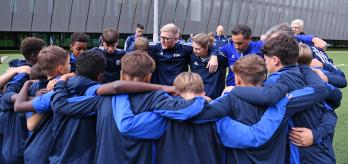Athletic Club Bilbao is famous for its unique policy of recruiting exclusively from its home region. Of course, this reduces the pool of youngsters the Basque club can draw from, so keeping those players fit is absolutely crucial. It was this requirement that led Dr Xabier Monasterio to carry out his groundbreaking research into growth-related injuries at the club’s academy, which he presents here for Science Explained. His presentation is followed by a Q&A, hosted by Dr Paul Bradley.
Define the key terminology surrounding injury and how the impact of selected injuries is assessed. Explain the difference between growth and maturity and what this means for efforts to mitigate injury risk in youth players. Describe some of the measures Athletic Club has taken to reduce injuries at its academy.
There is a distinct lack of research related to injury burden in youth academies, especially in the women’s game. The research presented shows that physical maturity has a significant effect on the types of injuries youth players are most likely to suffer. Once you understand this link, you can try to protect players against these injuries.
Clubs should consider how they monitor growth and maturation in academy footballers. Depending on the growth and maturation profile of their players, they might consider taking a range of measures to reduce injury risk, including modifying training load and the use of bio-banding, both on the pitch and in the gym.
Watch presentation
Read summary
Part 1: Key injury epidemiology variables
Before Dr Monasterio could identify major injury risks, he had to collect data on the injuries occurring at the academy. In the first part of his presentation, he describes how he trawled the club’s records to capture every injury suffered by the club’s youth players across the men’s and women’s game over a 10-year period. He then collated this longitudinal data to produce a “heat map” highlighting the most common and highest-impact injuries at all levels of the club. You can see an enlarged version of the heat map below.
Part 2: Growth, maturation and injury risk
As Dr Monasterio points out, growth is not the same as maturation, although the two are inextricably linked. Maturity can be measured in a number of different ways, but the most telling measurement for a sports scientist is often somatic maturity, which is a measure of how close a young player is to their full adult height. This is particularly significant because research shows that players’ vulnerability to specific injuries is linked to their somatic maturity. Once you understand this link, you can begin implementing procedures designed to protect youngsters as they move through the ranks.
Part 3: Reducing the impact of growth-related injuries
At Athletic Club, their procedure starts with monitoring players’ growth relative to Peak Height Velocity (PHV), which indicates how close they are to full somatic maturity. The club’s experts then liaise closely with coaches, fitness trainers, parents and players to ensure they are aware of growth-related injury risks and how to manage them effectively. There are a wide range of options available for mitigating injury risk in youngsters, such as limiting their playing time or introducing bio-banded gym sessions. This system relies on effective communication and education across all departments of Athletic Club’s academy.
Q&A
01:20
Which growth-related injuries have the highest impact in your academy?
03:08
Why do you think apophyseal injuries have such a high impact in your academy as opposed to other types of injuries (such as Osgood-Schlatter injuries)?
04:46
You mentioned the types of injuries you see at the academy and the circumstances under which they occur. For example, you mentioned that distal injuries are more of an issue before peak height velocity. Why is that? Are there specific biological issues or other factors we need to be aware of to understand why and when these injuries occur?
06:46
We know previous injury is a strong predictor of future injuries in senior players. Do youth players with a history of injuries as they develop tend to be more prone to injuries as senior players?
08:53
We talk a lot about scientific methods in these sessions. Which methods do you use to generate the visualisations and graphics in your reports, and how do you classify players in relation to peak height velocity?
11:41
In Science Explained, we really focus on how the science translates into practice. You mentioned some key points in relation to bio-banding, and particularly bio-banding for gym sessions. What do those bio-banded gym sessions look like, and what do you include in those sessions?
13:51
Another practical application you mentioned was optimising load on players. How well are the load-management strategies you are implementing in your academy working at the moment?
15:24
We have talked about growth and maturation in boys. What about growth and maturation-related injury risks in female players?
17:37
Which plans are the most important for academy staff to consider when looking to manage and mitigate the risk of injury in youth players?
19:33
What practical tips would you give practitioners on applying the science discussed in this presentation?



















